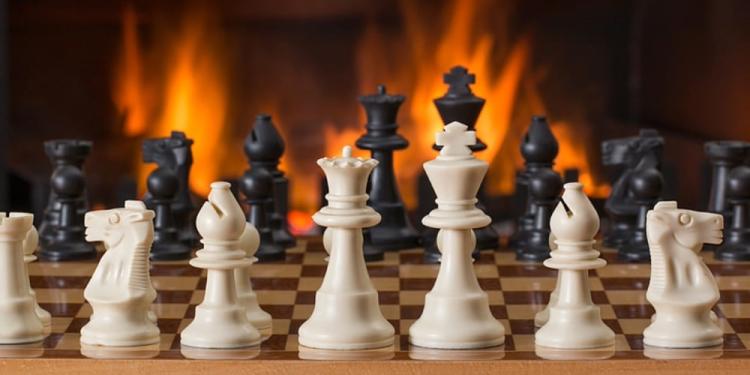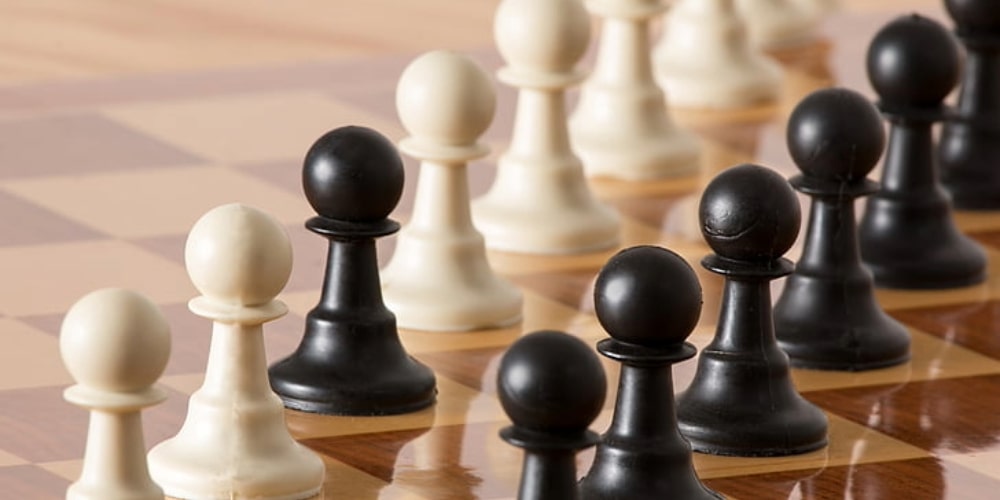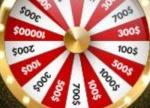Cheating In Chess – How To Gain An Unfair Advantage
Posted: August 27, 2024
Updated: August 27, 2024
As with all sports, the desire to win can cloud the judgement of players and sometimes encourage them to take shortcuts or utilise underhand tactics to gain an advantage. It's the same story with chess, with plenty of ingenious ways discovered when it comes to getting an advantage.

Chess, a game of strategy and intellect, has unfortunately seen its fair share of cheating throughout its history. From prearranged draws to the use of modern technology, players have sought unfair advantages to gain an edge over their opponents by cheating in chess.
The Early Days Of Chess Cheating
In the 18th and 19th centuries, some unscrupulous individuals devised elaborate schemes to deceive the public. They presented mechanical contraptions, known as “automatons,” as chess-playing machines. These devices were actually hoaxes, with hidden operators controlling the movements of the pieces. While these early instances of cheating in chess were more about deception than gaining a competitive advantage, they set a precedent for the unethical practices that would follow.
Mechanical Turk Cheating In Chess
The Mechanical Turk, a famous 18th-century chess-playing automaton, was a carefully engineered hoax. It was not a machine capable of playing chess independently but a human-operated device. Here’s how it worked:
- Hidden Operator – A skilled chess player was concealed within the machine, observing the game through a hidden compartment. Mechanical Movements – The machine’s movements were controlled by levers and gears, creating the illusion of autonomous operation.
- Magnetic Linkage – A magnetic connection between the chessboard and the hidden operator allowed the hidden player to monitor the board’s configuration and make strategic moves.
- Misdirection – The creators of the Mechanical Turk used various techniques to misdirect viewers and hide the human operator, such as opening compartments that revealed seemingly complex mechanisms.
According to online gambling news in the UK, the Mechanical Turk successfully fooled many people for years, including prominent figures like Benjamin Franklin and Napoleon Bonaparte. It was eventually exposed as a hoax by Edgar Allan Poe, who correctly deduced that a human operator was controlling the machine.
Collusion In Chess – A Longstanding Practice
Collusion, the practice of agreeing to a draw before a tournament game to preserve standing or energy, has been a controversial issue in chess for centuries. One of the earliest documented cases of collusion involved Preston Ware, an American eccentric who participated in the 1880 International Chess Tournament.

Ware admitted to engaging in collusive practices as early as 1876, highlighting the long history of this unethical behaviour in the world of chess. However, the most infamous accusation of collusion occurred in Curaçao in 1962, where several players were suspected of conspiring to manipulate the tournament’s outcome. This cheating in chess incident sparked widespread controversy and raised questions about the integrity of competitive chess.
Bobby Fischer Russians Collusion
In 1962, GM Bobby Fischer, aiming to achieve the world championship, finished fourth in the Candidates Tournament. Following this disappointing result, Fischer accused the top three Soviet players, GMs Tigran Petrosian, Efim Geller, and Paul Keres, of colluding to draw their games and conserve energy for their matches against him. While Fischer’s accusations were met with scepticism at the time, subsequent analysis suggests that he may have been correct.
The Soviet players, who dominated the chess world at the time, may have strategically agreed to draws to ensure they were fresh and well-rested for their encounters with Fischer. In response to Fischer’s allegations, the Candidates format was changed in 1965 to an elimination tournament, designed to prevent potential collusion and ensure fair competition. This change reflected the seriousness with which Fischer’s accusations of cheating in chess were taken and the desire to maintain the integrity of the world championship.
Cheating In Chess – Piece Manipulation
While cheating in chess often involves more overt methods like fixing games or using computer assistance, subtle violations of the rules can also provide an unfair advantage. One such violation is the touch move rule, which requires players to move a piece as soon as they touch it. GM Milan Matulovic, in 1967, became the first widely known player to intentionally violate the touch move rule.
In a difficult position against GM Istvan Bilek, Matulovic made a losing move but then retracted it, replacing it with a much better one. Despite Bilek’s protests, the arbiter, unaware of the initial move, ordered him to continue play. This incident highlighted the potential for players to exploit the touch move rule to gain an unfair advantage.
Istvan Bilek
The touch move rule continues to be a source of controversy in chess. In 2003, GM Zurab Azmaiparashvili, known for his erratic behaviour, violated the rule by touching one piece and then moving another. Unlike Matulovic’s opponent, Azmaiparashvili’s opponent did not protest, allowing the infraction to go unchallenged. While these two cases are the most well-known examples of touch move rule violations in cheating in chess, there have been other instances where players have inadvertently or intentionally breached the rule.
In 1994, GM Garry Kasparov briefly released a piece against GM Judit Polgar before moving it to a different square. This incident occurred so quickly that it’s unclear whether Kasparov was aware of his violation. Unlike Matulovic and Azmaiparashvili, who intentionally moved different pieces, Kasparov’s mistake seemed unintentional. However, these cases highlight the importance of strictly adhering to the touch move rule to maintain fair play in chess.
Hidden Pieces And Other Shenanigans
While most cheating in chess involves more straightforward methods like using computer assistance or manipulating pieces, some players have resorted to more creative tactics. GM Bator Sambuev, in 2017, was accused of intentionally hiding a piece during a game. While the extent of his actions remains unclear, it raised questions about the boundaries of fair play. In unregulated games, such tactics may be easier to conceal, but when playing against experienced grandmasters like GM Maurice Ashley, the chances of getting away with cheating are significantly reduced.
Bizarre Accusations In High-Stakes Matches
Today, the world championship is a highly competitive event that many of the top online sportsbook sites in the UK promote for bettors. However, throughout its history, it has been marred by numerous cheating accusations, some of which have been particularly bizarre. In the 1978 World Championship between GM Anatoly Karpov and GM Viktor Korchnoi, one accusation involved the use of yoghurt as a potential method for transmitting information. While this cheating in chess claim may seem absurd, it highlights the lengths to which some players will go to gain an advantage.
Cheating In Chess – The 1978 Yogurt Incident
The 1978 World Championship clash between GMs Anatoly Karpov and Viktor Korchnoi holds a unique place in chess history. Among the bizarre accusations Korchnoi’s team levelled against Karpov was the use of yoghurt as a method to transmit information. Korchnoi’s team claimed that Karpov’s assistant was delivering yoghurt in various flavours to transmit secret messages. This accusation, known as “yogurt-gate,” sparked a formal investigation. The initial yoghurt, a raspberry flavour, was delivered early in the game before any crucial positions had been reached. To address the concerns, a compromise was reached: Karpov could continue receiving yoghurt, but only in a single flavour and at the same time during each game.
While the accusation of yoghourt-based cheating in chess was ultimately dismissed, it remains a memorable and controversial episode in the history of chess. The incident highlights the lengths to which some players and their teams will go to gain an advantage, even resorting to outlandish claims and tactics.The lack of credibility surrounding this claim has made it a lasting source of amusement and a reminder of the intense psychological warfare that can accompany high-stakes chess matches.
The 2006 Bathroom Break Brouhaha
A more serious accusation of cheating in chess arose in the 2006 World Championship between GMs Vladimir Kramnik and Veselin Topalov. After falling behind, Topalov’s camp accused Kramnik of cheating during frequent bathroom breaks. While these accusations were ultimately unfounded, and Kramnik emerged victorious, the incident cast a shadow over the match.
Reflecting on the event in 2019, Kramnik condemned the behaviour of Topalov’s manager, IM Silvio Danailov, who was suspected of retaliating for previous accusations against him and Topalov. This incident highlights the potential for external influences to disrupt the integrity of the championship.
The Sandu Accusations Of Cheating In Chess
The 2015 European Women’s Championship was marred by controversy surrounding WGM Mihaela Sandu’s early success. Despite her strong start, Sandu was accused of cheating in chess by other players, leading to a heated debate within the chess community. While there was little evidence to support these accusations, Sandu faced a ban not for cheating but for instigating the controversy.
The incident highlights the potential for unfounded accusations to damage the reputation of innocent players and create a toxic environment within the chess community. It’s important to note that winning games alone is not evidence of cheating. Accusations of cheating in chess should be based on concrete evidence and not on mere suspicions or personal animosity. The Sandu case serves as a reminder of the need for fair play, respect, and evidence-based investigations in competitive chess.
Engine Cheating In Chess
With the advent of powerful chess engines, cheating in chess has become more direct and accessible. Instead of resorting to collusion or other deceptive tactics, players can now use computer assistance to gain an unfair advantage. While chess engines have become increasingly sophisticated over the years, their ability to significantly impact human games has existed for decades. Accusations of engine cheating date back to 2006 and earlier, highlighting the ongoing threat posed by this form of technology.
While Stockfish, a leading chess engine, has gained prominence in recent years, it’s important to note that engine cheating in chess predates its existence. Players have been using various forms of computer assistance to improve their performance for many years. In addition to engine cheating, other forms of cheating, such as prearranged draws, continue to be a concern in the chess world. The case of GM Sergey Karjakin, who achieved the record for the youngest grandmaster in 2002, has been subject to scrutiny regarding potential collusion.
Early Cases Of Engine Cheating In Chess
One of the earliest suspected cases of engine cheating in chess occurred in 1993 at the World Open. A player named John von Neumann, who displayed minimal chess skills and spent much of his time staring at the ceiling, managed to score a respectable 4.5/9, including a draw with a grandmaster. The most blatant example of engine cheating was committed by GM Igors Rausis in 2019. He was caught conferring with a chess engine in a bathroom stall during a tournament, leading to a six-year ban and the loss of his grandmaster title.
The Rausis And Nigalidze Scandals
The cases of Igors Rausis and Gaioz Nigalidze, both caught using phones in bathroom stalls during chess tournaments, highlight the growing problem of engine cheating. While these incidents may seem comical, they have serious consequences for the players involved and the integrity of the game. Gaioz Nigalidze was caught using a phone in 2015, thanks to a tip from GM Tigran L. Petrosian.
The irony is that Petrosian himself was later caught cheating in 2020, highlighting the hypocrisy of accusing others while engaging in similar misconduct. These cheating in chess scandals have raised concerns about the prevalence of cheating in chess and the need for stronger measures to prevent it. The use of technology has made it easier for players to access and use chess engines, making it imperative for organisers to implement robust anti-cheating measures.
Combating Cheating In Chess
Chess, a game of strategy and intellect, has unfortunately seen its fair share of cheating attempts. With the rise of online chess, as well as chess betting on platforms like Bet365 Sportsbook, and the increasing sophistication of chess engines, catching cheaters has become an ongoing challenge. The anonymity and accessibility of online chess make it easier for players to cheat using chess engines. These powerful programs can analyse positions and suggest the best moves, giving players an unfair advantage.
Detecting online cheating requires advanced algorithms that monitor player behaviour, such as switching between tabs or applications during games. Additionally, some platforms like Chess.com use camera monitoring to ensure players are focused solely on the game. However, these methods aren’t foolproof. Sudden improvements in a player’s skill can raise suspicion, but it can also be a sign of genuine development. Anti-cheating in chess experts, like Kenneth Regan, work to identify legitimate growth patterns to avoid unfairly accusing players.
Over-the-Board Challenges
Cheating in over-the-board chess is less frequent but still a concern. Historically, like casinos, cases have involved hidden devices and accomplices transmitting moves or signals. To combat this, some tournaments employ broadcast delays, preventing real-time collaboration with external sources. Additionally, metal detectors and scanners are used in major events to identify hidden electronic devices. Chess.com’s CEO, Erik Allebest, highlights the importance of human intervention in anti-cheating efforts.
His personal story of confronting a suspected online cheater at their home demonstrates the lengths some platforms are willing to go to maintain a fair playing field. The battle against chess cheating requires a multi-pronged approach. By combining technological advancements with human oversight and continuously developing detection methods, chess organisers and platforms can strive to ensure the integrity of the game for all players. Obviously, any cheating during a game is going to have serious repurcussions on those onlookers who enjoy betting on chess.
Chess.com’s Fight Against Cheating – Taking A Multifaceted Approach
Chess.com, a leading online chess platform, is actively combating cheating in chess in a bid to maintain a fair and enjoyable experience for all players. In 2023, Chess.com banned over a million accounts, including 165 titled players, for violating fair play rules. This demonstrates the prevalence of cheating, even at the highest levels of online chess. Chess.com CEO, Erik Allebest, acknowledges the difficulty in tackling cheating. He compares it to a public relations nightmare, similar to finding unsafe candy. Unlike over-the-board chess, online cheating in chess requires less effort, making it a more significant concern. To seek out chess cheats, Chess.com utilises the following techniques:
- Dedicated Staff – Chess.com has invested heavily in anti-cheating, with a team of 30 dedicated staff members working diligently to identify and address suspicious activity.
- Technological Advancements – Mathematical models developed by experts like Kenneth Regan analyse player performance and identify patterns that might suggest the use of chess engines.
- Human Intervention – Chess.com acknowledges the importance of human oversight. Mr. Allebest mentions monitoring online communities like Discord groups to stay updated on potential cheating methods.
Cheating In Chess – The Struggle To Maintain The Integrity Of The Game
Chess is a game of strategy and intellect. While cheating in chess will likely continue, platforms and organisers are constantly developing new methods to detect and prevent them. By combining technological advancements with human oversight, the chess community can strive to ensure a fair and enjoyable experience for all players. If you’re interested in betting on chess, the Bet365 Sportsbook offers great odds, as well as plenty of background information on individual matches and tournaments.
Click here to try the best odds at bet365 Sportsbook












